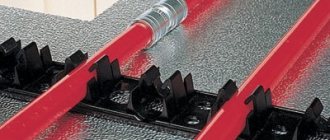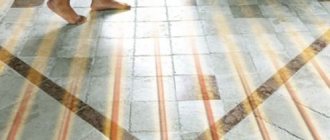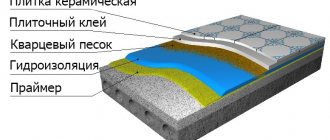Concrete floors
Concrete floors on the ground do not provide for a basement or space under the floor for ventilation.
Important!
When arranging concrete floors on the ground with a close standing of underground waters, it should be borne in mind that their level can change within a short time. This must be taken into account when laying the layers.

Concrete floor appearance
A classic floor on any soil consists of 10 layers:
Layers that protect from groundwater and distribute the load
- Compacted clay pillow. It is necessary to stop the rise of groundwater. If, after removing a layer of soil, you get to the clay, then it must be properly prepared. The clay layer cuts off the penetration of ground water upward.
- Sand pillow. Its purpose is also to prevent the ingress of groundwater and equalize the load on the ground. The sand weakens the capillary rise of water and evenly distributes the pressure of the layers above it on the ground. Any sand will do.
- Large crushed stone. This is a kind of drainage, its purpose is to make the base solid, to distribute the load. It generally does not allow water to flow upward due to its capillary property. Crushed stone is used in fractions of 40–60 mm.
The first three layers should be arranged in this order, each with a thickness of 10 cm in the compacted state. The layers must be compacted.
Advice.
It is difficult to compact a thick layer of sand or clay manually, therefore, when filling such a layer, you need to successively add and tamp thinner layers (10-15 cm).


Concrete floor layers
- Waterproofing layer (roofing material or polyethylene film). It is placed directly on the crushed stone, and it serves both to protect the crushed stone from the concrete solution flowing into it from above, and as an obstacle to the penetration of water vapor into the concrete layer from below. The film is laid with a whole sleeve (without cutting) with an overlap, put on the walls, gluing the overlap with tape.
- Rough screed 80 mm and thicker. For it, you should take washed sand and fine gravel (10–20 mm). Steel fiber is added to the solution or reinforcement is used. For the screed to be ready for the next stages of work, it must be kept for a certain time.
- Waterproofing layer (coating, roll or film waterproofing). If the first layers are laid correctly and efficiently, for waterproofing, you can use roofing material without powder in 1-2 layers or a film with a thickness of at least 120 microns. The waterproofing layer must be monolithic. If roofing material is used, the overlaps are coated with bitumen mastic, the overlaps of the plastic film are glued with tape.
- Insulation. You can insulate the floor with expanded clay, extruded polystyrene foam, foam. The thickness of polystyrene plates and polystyrene sheets depends on climatic conditions, but not less than 5 cm. Expanded clay is covered with a layer of 15 cm.
- Waterproofing. It is recommended to install waterproofing on expanded clay or other insulation. This will protect the insulation from moisture from the upper layers and improve its thermal insulation properties. At this stage, a thick polyethylene film is used, which is laid in a continuous layer.
- The screed is fine. It can house underfloor heating (hot water heating circuits, cable mats or heating cable). A layer of finishing screed is poured 50 mm or more. It is reinforced using composite or steel reinforcement, fiber is added to the solution.
- Finish coating. If all layers are made in the specified order, you can lay any coverings.
What the developer will need to remember
Insulate the base and floor properly on the ground, otherwise most of the heat will go into the soil
The structure of the floor foundation on the ground has an enhanced operational ability. But for this you need to choose the right material.
To make it easier to understand the structure of the cake from the inside, you will need to study the factors that affect the concrete slab:
- The emergence of the heaving influence of the soil under a residential building is extremely rare. Country houses can be installed on various types of bases, but all of them are installed on the ground. If the insulation of the sole is not of high quality, or is absent altogether, most of the heat will rapidly go into the layers of the soil. This will keep the basement or basement under the house warm, which can make it difficult to store vegetables. To prevent this from happening, it is imperative to carry out high-quality insulation.
- Each building project should include drainage protection from water, which often appears in the spring season from melting snow. If there is moisture drainage, groundwater is not formed under the foundation structure, thereby the soil will be dry.
It is not necessary to lay geotextiles under a sand cushion - the compaction will deteriorate - In many cases, the soil structure beneath a residential building will settle even if no heaving occurs. Sometimes the foundation tape is attached to the floor structure with reinforcement. When the soil subsides under the floor, space is created, and the concrete slab sags because it is anchored to the base. To avoid this situation, backfilling is performed at the time of construction. The pit is dug, after which it is covered with rubble and sand. After a certain thickness, compaction is performed. If all conditions are met correctly, there will be no shrinkage.
- Most construction organizations believe that at the time of the installation of a sand cushion, a geotextile material is preliminarily laid under the base of a residential building. But, according to experts, in this case, the result of compaction of a sand or crushed stone cushion will worsen. During the tamping period, the layers of the cushion are pressed together with the soil that is placed below. It is best to install a drainage system under this cake.
Due to the above factors, special attention should be paid to the laying of the cake in the case of a strip base. This will significantly increase the reliability of the entire structure as a whole.
It is important at the time of building the foundation to remember that engineering structures may fail after some time, and it will not be possible to replace them. To solve this problem, you can carry out a redundant engineering type system.
Pros and cons of concrete floors on the ground
Benefits
- They reliably protect the room from the cold. No matter what the weather is outside the window, the ground will always be warm.
- Any insulation and waterproofing materials are applicable, as well as any coatings for finishing the floor.
- The main load is distributed over the ground, no additional calculations need to be done. If a heavy load is expected, you just need to increase the thickness of the bottom three layers.
- It is possible to organize the heating of the house through the floor, which will quickly heat up and distribute heat evenly, preventing drafts.
- Protect the house from mold and microorganisms.


Concrete floor on the ground
disadvantages
- It is required to take into account the location of the groundwater level.
- They can significantly reduce the height of the room with certain design features of the house.
- The technology is not applicable for pile and columnar foundations.
- If a system malfunctions, repairing and dismantling it is a very time-consuming and costly undertaking.
- The installation of floors is a long and complex procedure in terms of the volume of work, as well as costly in finance, it is best to do this work when building a house.


Due to the number of layers, concrete floors on the ground can make the room lower
Screed varieties
Arrangement of the floor on the ground is carried out in two techniques - dry and bulk. The choice of technology is at the discretion of the site owner.
Dry screed
The technology provides for the formation of layers - cushions based on crushed stone, sand filling, rough screed and waterproofing. Then, using special ready-made mixtures, the floor covering is screed. The finished compositions are laid as follows:
- Install beacons (strips or profiles), fix them with putty.
- Crumbled expanded clay composition is poured between the lighthouses. Level the material over the waterproofing layer.
- Plates are laid, which are fixed with glue-sealant or using self-tapping screws 19 mm long.
Upon completion of the installation work, the edges of the film are cut off, and the resulting gaps are sealed with a sealant.
Self-leveling floor screed
Self-leveling floor technology creates a perfectly smooth surface for subsequent finishing. The arrangement of the coating has a number of features:
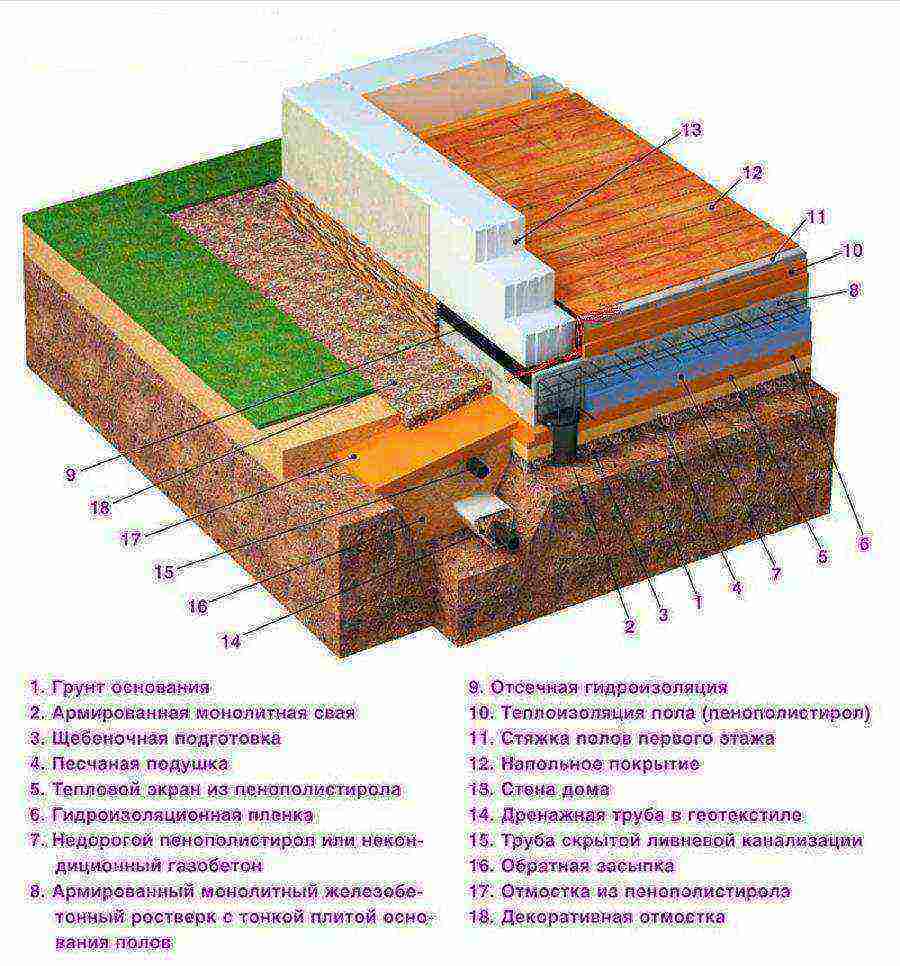

- The waterproofing layer is cleaned of dust and treated with liquid glass diluted with water in a 2: 1 ratio. The surface is processed in 2-3 layers, after each layer has completely dried (1 hour);
- The pouring mixture is prepared by hand on the basis of bulk material and water. The composition must be kept for 10 minutes and the batch is repeated.
- The mass is poured onto the floor with a layer of 0.3-1 cm and leveled with a spatula.
- Air bubbles are eliminated - a needle roller is rolled on the surface.
- The mixture formed after drying is eliminated using a putty mesh.
- Finishing is carried out after the mass has solidified.
Arrangement of a self-leveling screed compensates for the load of the house, eliminates wall shrinkage, and isolates noise from heating equipment.
How to make a concrete floor yourself on the ground
It is best to remove the soil and fill the first three layers immediately after the foundation of the house. First, calculations are made to what depth the soil needs to be removed. The level of the finished floor is taken as the zero mark. Add up the dimensions for the thickness of each layer, for example:
- laminate + backing — 1.5 cm;
- screed + waterproofing - 6 cm;
- thermal insulation + waterproofing - 6–11 cm;
- concrete screed 8–10 cm;
- crushed stone, sand, clay - 15 + 15 + 10 cm;
The total value is 61.5 cm. If the layers are thicker, the soil will have to be removed to a greater depth. Add 5 cm to the resulting depth.
A hole is dug over the entire area of the building to the calculated depth and the soil is removed. For the convenience of subsequent work, the levels of the floor layers are marked on the walls of the foundation along the entire perimeter. This will make it easier to align them. The soil does not necessarily contain clay; for clarity, we give the procedure for working on soil that does not have a layer of clay.
Floors on the ground: preparation and pouring
Clay.
Any clay is poured with a layer thickness of at least 10 cm. It is leveled and poured abundantly with weak liquid glass (solution of 1 part of glass in 4 parts of water). The wet layer is tamped with a cut of a bar 200x200mmx1.5 m. On a large area, you can use a vibratory rammer or vibro-compacting machine by renting it. If, as a result of compaction, the layer turns out to be thinner, the clay is poured and compacted again.
Advice:
a durable rammer can be made from a cut of a channel (20x30 cm) by welding a piece of metal pipe to it, into which sand is poured to make it heavier.


Clay is one of the layers of the concrete floor
The leveled compacted clay layer is poured with cement milk (2 kg of cement are stirred in 10 liters of water) so that there are no puddles, and left for a day so that the process of chemical interaction of cement with liquid glass is completed completely. It is not recommended to walk on it at this time.
Sand
Trying not to walk on the prepared clay layer, sand is poured over 15 cm. You can walk on it.It is leveled and also compacted to the appropriate mark on the wall of the house's foundation.
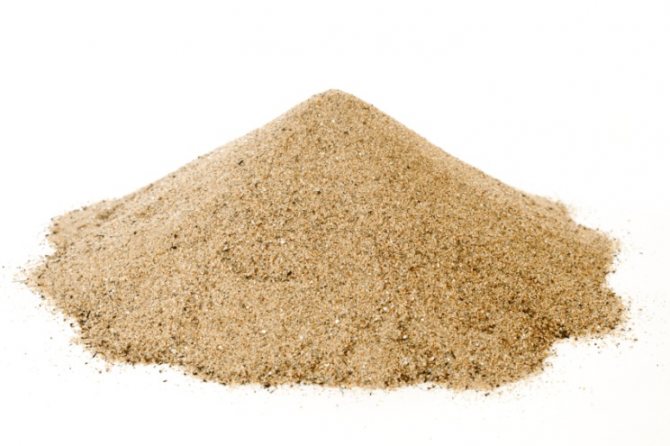

Sand must be leveled and tamped
Crushed stone
It is poured onto the sand and also carefully compacted with a rammer. Particularly carefully align the crushed stone in the corners, tamping it tightly. As a result, you should get a flat horizontal surface.


Crushed stone must be tamped as tightly as possible
Polyethylene film
Uncut sleeves are laid with an overlap of 10–15 cm, and placed on the walls by 3–5 cm. The overlaps are carefully glued with tape. It is recommended to move in shoes with soft soles, taking care not to damage the film with sharp edges of pieces of rubble. Although experts claim that this is just a technological technique, the film also performs its waterproofing functions.


The plastic wrap must be overlapped
Rough screed
For it, you can order ready-made "skinny" concrete or make a mortar yourself by mixing M500 cement with crushed stone and sand in a volume ratio of 1: 4: 3. Metal fiber is also added to the mixture in the amount of 1–1.5 kg per 1 m3 of solution. The mortar can be poured by aligning with lighthouses or with marks on the walls of the foundation. It should be borne in mind that the flat horizontal surface of the rough screed will simplify the further stages of the flooring.
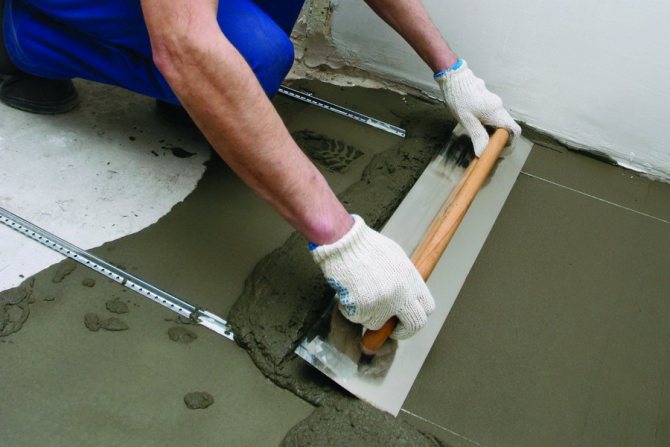

The rough screed must be flat
Two days later, the concrete is ironed with a mixture (10: 1) of water with liquid glass and dry cement. They do it like this: moisten the entire surface of the screed with a roller or spray gun, then sprinkle it with a thin layer of dry cement and rub it with a float into the concrete. Such a technique will increase the strength of concrete by an order of magnitude and increase its resistance to water. The screed requires at least 1.5 months to fully mature, but subsequent work can be carried out after 1–2 weeks.
Waterproofing
The prepared rough screed is covered with liquid bitumen (primer), especially carefully smearing the corners and capturing 5 cm of the walls. On such a base treated with bitumen, strips of roofing material are glued with an overlap of 10 cm and an overlap of 5 cm of the walls. In places of overlap, the strips are heated with a hairdryer or coated with bituminous mastic.


The draft screed must be covered with a layer of waterproofing
The strips of the second layer are placed with a shift of half a strip in the same way. Roofing material is especially carefully glued in the corners of the room. When performing this type of work, it is recommended to walk on the floor in shoes with soft soles.
Thermal insulation
The purpose of this layer is clear. The best material in this case will be extruded polystyrene foam (EPS) plates. A 5 cm thick sheet of this heat insulator in its effectiveness replaces expanded clay, poured in a layer of 70 cm. The material practically does not absorb water and has a high compressive strength.
To make EPS sheets more effective, they are recommended to be laid in 2 layers, each of them 3 cm thick, shifting the joints by 1/3 or 1/2 sheets. This will completely eliminate cold bridges and improve the thermal insulation properties of the insulation. The joints of the EPSP boards in each layer should be glued with special tape.


Insulation layer
If expanded clay or mineral wool is used as insulation, an additional layer of waterproofing material, for example, polyethylene film, will be required to protect the insulation from the moisture of the finishing screed.
Finishing screed
Along the perimeter of the room, a damper tape 1.5–2.0 cm is fixed to the walls to the entire height of the screed. The end of the damper tape is fixed on the insulation plates. The screed is reinforced with a 3mm masonry mesh with a mesh size of 100x100. If you plan to install a warm electric floor, a reflective waterproofing material is placed on the EPSP sheets. When installing water heating circuits, the thickness of the screed will be needed more, the water heating pipes must be in the thickness of the screed.
The reinforcing mesh is positioned so that it is in the screed and does not protrude onto its surface. To do this, use stands, pieces of wooden bars, metal profiles or, for example, corks from plastic bottles. The combination of fittings and leveling beacons is a rather difficult task, therefore it is recommended to pour the screed along the mark on the walls, and then pour a thin layer of the self-leveling self-leveling floor over it.


Finishing screed application
For screed, use ready-made dry mixtures or prepare a solution from river washed sand and cement in a ratio of 3: 1. The work is done quickly. The screed will harden for 4–5 days, and its final readiness will be in a month. The use of ready-made mixtures with special additives will accelerate the maturation process of the screed. Its readiness is checked with a paper napkin, laid on the floor and covered with a sheet of polyethylene. If the napkin remains dry after a day, the screed is ready for applying a self-leveling mixture and installing topcoats.
Preparatory stage
Before installing the insulated screed, mark it
This stage of work involves preparing the soil for the upcoming loads and installing an insulated screed. To do the work on your own, there is the following procedure:
- Performing markup. Measure the floor of the basement, if it is absent, then the first floor. These marks will serve as the starting point of the overlap, and this surface will also be the place on which you walk. The threshold of the room, be it a basement or an entrance to a private building, will be the starting point. The thickness of the concrete slab is subtracted from the reference point. At the next stage of the work, several marks are made on the foundation. Thus, the points of the lower and upper part of the overlap become known. You can perform all actions using a level, with its help, the accuracy will increase and the work process will be significantly accelerated.
- Further preparatory actions. For a concrete slab, or rather a floor, dense layers of soil will be the basis in the basement. You can use a vibrator to compact the soil. However, to use this mechanism, you will need a special tool. Also, the compaction of the soil structure can be performed using a bulk mass, which is a log with a diameter of at least 30 cm.To accomplish this important task, a wide area is attached to the tree trunk. Under its influence and the total weight of the wood, the soil is compacted.
- The preliminary actions in relation to the monolithic slab of the strip base are additional bedding throughout the basement. To make it, you will need such building materials as: sand or crushed stone of the middle fraction. At the time of purchasing material for backing, it should be remembered that the sand must be chosen at least of an average size. The size of the backfill layer should not exceed 50 cm. The sandy appearance of the pillow plays the role of a drainage system that evenly transfers the mass from the building to the ground. In some situations, in order for the layers to be denser, they are watered with a small volume of water, after which they are sprinkled and tamped again.
- An important component of a tape-type base is the laying of high-quality moisture protection. Most often, an ordinary film is used for this, which is made of polyethylene or membrane types of materials with a high density. Pouring a concrete screed can be performed only after the waterproofing has been expanded around the entire perimeter of the room. It is important to remember that all joints of the waterproofing material should be connected exclusively with an overlap. The film must be made larger than the area of the room, this is necessary in order to perform the bending of the edges. For details of preparation and laying on the ground, see this video:
It is important to remember during the screed pouring that the floor structure can be made warm.This action can be performed using the underfloor heating structure. It runs on electricity, while consuming a small amount of energy, but heats the entire area well.
Wooden floor on the ground on logs
In private houses, wooden floors are most often made. There are several reasons for this:
- in frame houses, the wooden floor is a continuation of the general structure of the building;
- wood is a natural material that is safe for the health and life of the residents of the house. Certain types of wood have a beneficial effect on health;
- wood is easy to handle and lay even for a beginner in construction work;
- wood treatment with antiseptics significantly increases its service life;
- the floors are easy to repair and open if necessary.
The device of a wooden floor on the ground in a private house on the first floor is quite feasible with your own hands. The floor can be insulated, communications, basement can be hidden under it. It is laid on logs, which can be mounted when tying the strip foundation.


The structure of the wooden floor on the ground on the joists
As a lag, logs sawn into two halves are used, bars with an aspect ratio of 1: 1.5, double thick boards of coniferous trees. If the logs were not mounted when tying the foundation, they can be placed on prepared soil or on brick posts on a concrete base.
Logs are placed at a distance that is determined by the thickness of the floorboard. So, if the board is 50 mm, the logs are installed after 100 cm, if the board is 35 mm, the logs are placed after 60 cm. The first and last logs are installed at a distance of 20 cm from the wall, the rest are placed between them. If the distance between the lags is slightly greater than required, then the number of lags is increased, and the extreme ones do not shift. If the room is rectangular, the logs are laid along the long wall. For a square room, there is not much difference.
Installation of logs on the ground (cold floor without underground)
The work is performed in the following order:
- They calculate to what depth to remove the soil, based on the thickness of the log, layers of sand, crushed stone, clay or expanded clay.
- They remove the completely fertile layer of the earth and dig deeper, based on the calculated depth. The remaining soil is well leveled and compacted over the entire area of the future floor. Seal with a tamper. On large areas, you can use a vibrator to compact the soil.
- Any sand is poured with a layer of 15 cm or more and the same layer of crushed stone (or construction debris) and rammed. If the house is on clay soil, a layer of clay is poured and rammed, and then sand and crushed stone are successively placed on it. If the soil is sandy, then you can fill in a layer of calcined sand or slag ventilated for at least a year. You can pour a layer of expanded clay. The thickness of all layers of the fill should be approximately three times the height of the log. All layers are carefully leveled and tamped.
- On the leveled top layer (sand, slag or expanded clay), lags treated with an antiseptic are installed, they are sunk into the bedding and ram well around. The upper level of the lag should be located so that the floor boards are in the right position. The lags are attached to the foundation or the lower crown.
- Floor boards are mounted on the logs.


After installing the log on the ground, they begin to mount the floor
Logs on brick posts (warm floor with underground)
Usually logs are installed on posts stacked in 2 bricks (25x25 cm).
- Fertile soil is removed, the remaining soil is leveled and tamped.
- Carry out a marking of the locations of the posts for the logs (in the event that the logs are not installed when tying the foundation). The height of the posts depends on which part of the wall the logs will rest on. It can be a bar of the first row or a grillage (covered with roofing material, a bar for strapping the foundation).
- Pull the cords so that they are located above the center of all the planned posts, and pegs are driven into the ground at an equal distance from the cords to the width of the brick posts (25 cm in each direction).


Lags are installed on brick posts
Bases for posts
In the marked places, holes are dug 40x40 cm in size and 15–25 cm deep on rocky or sandy soil and up to 45 cm on clay and loose soils. A layer of sand of 10 cm and a layer of crushed stone of a coarse fraction of 10 cm are successively poured into deep pits and rammed.
Advice
: If the water table is close, the holes can be filled with a 20–25 cm layer of clay and tamped down (this is a clay castle).
- The bottom of the pits is covered with plastic wrap or roofing felt.
- The concrete base under the brick posts is poured so that it protrudes 5 cm above the level of the compacted soil. For this, formwork is installed from boards (about 5 cm high above the ground) and reinforcement in the pits. As reinforcement, you can use wire or mesh with 10x10 cm cells.
- Concrete is poured (cement: sand: crushed stone (fr. 5-10 mm) = 1: 3: 2-3 and water to a thick consistency) and left to mature for several days.


Preparing the base for the posts
Making posts
- Roofing material is laid on a concrete base in 1-2 layers so that it protrudes 1-2 cm beyond the edges.
- Brick posts in 2 bricks are laid out strictly vertically (along a plumb line) on roofing material so that the last layer of bricks is perpendicular to the direction of the log. To obtain a solution, mix M100 cement and sand in a volume ratio of 1: 3 and add water by eye.
- Roofing material is placed on the column and a lining made of antiseptic treated plywood or square OSB board is placed on it, so that it protrudes 2 cm beyond their edges.
Installation and alignment lag
Lags are installed on these pads. Aligning the lag is a long and painstaking work. For this, pads are used or part of the support is cut off. As a result, all lags should be at the same level.


You can check the quality of the lag installation using the level
Aligned, they are attached to the posts with corners, and to the elements of the walls or foundations - with special fastening systems used for the construction of frame houses. Holes are pre-drilled in the concrete and dowels are inserted.
Floor installation
Next, proceed to the installation of a cold or warm floor. Cold floor boards are directly laid on the joists.


The last stage of the process is the installation of the floor.
- For a floor with insulation, bars of 30x50 or 50x50 mm are attached to the lower part of the log, on which a rough floor is laid from a thin unedged board 20 mm thick.
- A vapor barrier (vapor barrier membrane) is laid on the sub floor.
- A soft insulation (mineral wool) is placed on the membrane, so that its sheets fit tightly between the logs and tightly adjoin one another, not reaching about 2 cm to the top of the log.
- Floor boards are laid on the logs.

